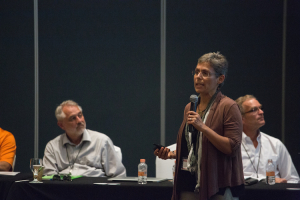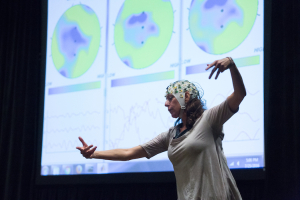More than 100 engineers, scientists, artists, industry and media representatives came together for the 2016 International Conference of Mobile Brain-Body Imaging and the Neuroscience of Art, Innovation and Creativity (“Your Brain on Art” conference) in Cancun, Mexico to better understand what happens inside of the brain when art is created or contemplated, and potential applications in medicine, science, engineering, education and the creative arts.
The invitation-only conference was held last July and encouraged leaders in the science and art fields to collaborate and discuss the future of neuroaesthetics and neurocreativity. There were also demonstrations of mobile brain-imaging (MoBI) technology that allowed dance performers to visualize their brain activity ‘in action and in context’.
“Your Brain on Art” is a partnership between the University of Houston’s Non-Invasive Brain Machine Systems Laboratory and Blaffer Art Museum. Jose Luis Contreras-Vidal, Hugh Roy and Lillie Cranz Cullen Distinguished Professor of electrical and computer engineering, pioneered the “Your Brain on Art” partnership and served as chair of the conference. Klaus Gramann, Professor of Biological Psychology and Neuroergonomics at the Berlin Institute of Technology served as the co-chair of the conference.
“It was important that we brought together experts from a variety of disciplines to ensure that we had the most challenging and enriching discussions possible,” said Contreras-Vidal. “Creativity and aesthetic experience are essential qualities in the arts, science, engineering and medicine, and thus it is important to understand, measure, and promote neural activity associated with creativity.
The discussion topics at the conference touched on five critical areas and focused on development of a strategic plan for inclusion of creativity in science and engineering. These areas included: understanding human responses to emotional stimuli such as the creative arts, our physical environments and our interactions with technology; finding best methods for reverse engineering the brain to understand aesthetic and creative experiences; identifying the artistic, scientific and engineering challenges that affect collaboration and innovation; promoting or enhance creativity; optimizing and personalizing art as a form of therapy; and designing new tools for understanding and promoting creativity, health and wellness.
With the support of the National Science Foundation (Award # IIS 1631608) and the Office of Naval Research Global (Award N62909-16-1-2065), conference organizers invited selected graduate students and postdoctoral fellows to participate in the high-level discussions with the world’s leaders and innovators in neuroscience, technology, medicine, education, media and industry.
“As future researchers, we are counting on the students and fellows to carry on this work,” said Contreras-Vidal. “Because of this, we felt it was not just beneficial, but necessary for them to be a part of the discussion.”
View photos from the event here and watch our videos here.

